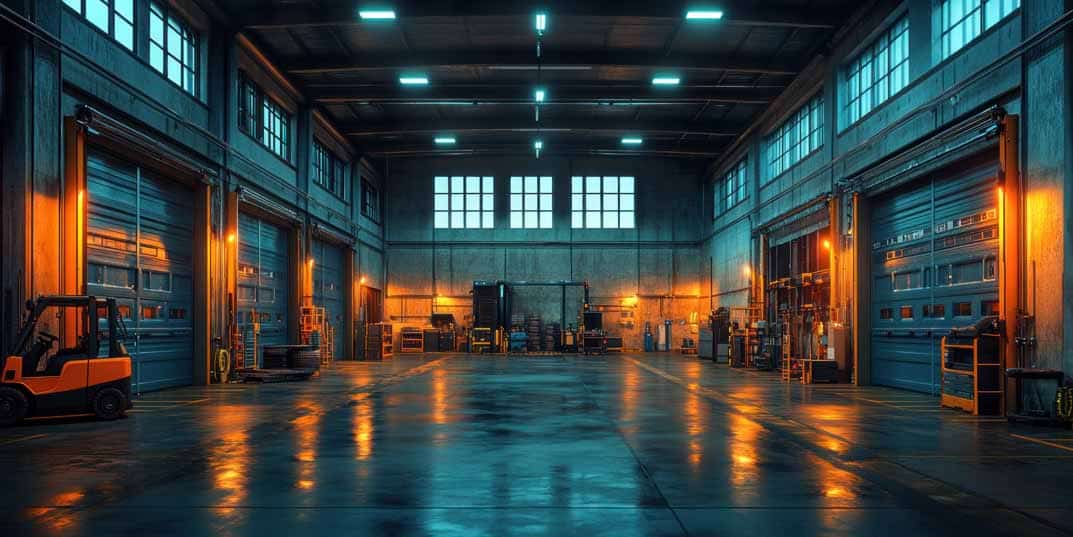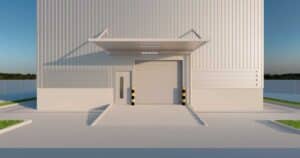Topics Covered:
If your business revolves around heavy equipment—like construction loaders, industrial forklifts, excavation rigs, or large-scale farming machinery—you already know how critical a robust garage door is. Standard commercial doors might handle moderate usage, but they often fall short when faced with immense weight, extra-wide vehicles, and constant cycling. That’s where heavy-duty garage doors come into play, featuring specialized load-bearing tracks and high-cycle springs designed for the demands of big machinery.
Why Heavy-Duty Doors Are Essential for Heavy Equipment
Organizations that rely on large-scale machinery—whether in construction, manufacturing, agriculture, or logistics—face unique challenges when it comes to garage door usage. These specialized vehicles often exceed the dimensions and weight tolerances of average commercial doors, leading to premature wear, frequent malfunctions, or even safety hazards if the door fails under stress.
Key reasons to invest in heavy-duty doors include:
- Vehicle Size and Weight: Standard overhead doors may bend, warp, or get knocked off their tracks when faced with tall loaders or multiple-ton excavators.
- Frequent Cycling: Operations that require rapid in-and-out movement multiple times a day put enormous stress on door components. A typical commercial door might cycle 10,000 times in its lifespan, but heavy-duty doors can handle 25,000 to 100,000+ cycles.
- Operational Efficiency: Downtime caused by a broken or stuck door can stall the entire worksite, costing thousands of dollars in delayed projects or idle labor.
- Safety Concerns: A malfunctioning door can injure workers, damage high-value equipment, or compromise site security.
Considering these points, it’s clear that investing in a purpose-built, heavy-duty door isn’t just about convenience—it’s a strategic move that can save time, money, and headaches in the long run.
Understanding Load-Bearing Tracks
Load-bearing tracks form the backbone of any heavy-duty garage door system. In a standard commercial door, the tracks are usually thinner steel that can handle moderate weight. But when you’re dealing with forklift traffic, daily construction rig movements, or extra-wide agricultural harvesters, you need tracks that won’t buckle or misalign under pressure.
- Thicker Steel Gauge: Heavy-duty tracks are typically made from 12- or 14-gauge steel (lower gauge numbers mean thicker metal). This structural reinforcement resists bending even if a large vehicle accidentally nudges the door.
- Deeper Track Profile: The deeper the track, the more stable the door’s movement. This prevents the rollers from jumping out of place when a door is raised or lowered at high speed.
- Mounting and Bracing: Heavy-duty systems often include reinforced mounting brackets and cross-braces that anchor the track firmly to the garage wall or ceiling. This distributed stress design prevents the track from wobbling or loosening over time.
At RJ Garage Door Services, we often see businesses underestimating the track requirements for heavy machinery. They might invest in a door with stronger panels but overlook the track system, leading to premature component failure. A properly rated load-bearing track is essential to ensure the entire overhead door assembly holds up for years—even decades—under constant heavy usage.
High-Cycle Springs: The Heart of Frequent Operation
Another key component for heavy-duty doors is the spring system. Traditional torsion springs are rated for around 10,000 cycles, which might be enough for a small auto-repair shop but pales in comparison to the needs of a busy heavy-equipment facility. High-cycle springs are specifically engineered to handle tens of thousands—or even hundreds of thousands—of up-and-down movements without snapping.
- Larger Wire Diameter: High-cycle torsion springs use a thicker wire diameter to handle greater tension without fatigue.
- Extra Coils: By adding coils, the spring can distribute stress more evenly, lengthening its operational lifespan.
- Material Quality: Springs made from corrosion-resistant steel or treated alloys stand up better in harsh environments—critical for sites where dirt, moisture, or chemicals might be present.
Replacing a broken spring in a facility with large machinery isn’t just a hassle; it can bring operations to a complete halt. With high-cycle springs, you significantly reduce the risk of unexpected downtime, ensuring your door remains operational—and your heavy machinery keeps rolling—day after day.
When to Consider a High-Speed Door
While robust construction is crucial, certain operations also benefit from a high-speed door. These doors can open at speeds of up to 24-36 inches per second, compared to just 6-8 inches per second for standard commercial doors. In a busy environment where multiple pieces of equipment come and go, seconds add up to minutes, and minutes add up to hours of saved labor over time.
- Reduced Energy Loss: By cutting the open time, you minimize the amount of conditioned air escaping or outside air entering, which can help keep climate-controlled facilities more efficient.
- Improved Traffic Flow: Large vehicles can move in and out with minimal waiting, reducing congestion and potential accidents in loading areas.
- Less Wear on Components: Contrary to what you might think, high-speed doors are often designed for less wear per cycle because they utilize advanced motors and control systems that handle movement more efficiently.
If your warehouse or equipment garage sees dozens of entries and exits a day, a high-speed door might be a game-changer. Combined with load-bearing tracks and high-cycle springs, it can form an optimal system for maximum throughput.
Door Materials for Heavy-Duty Environments
Even the sturdiest tracks and springs won’t help if your door panels themselves aren’t up to the task. For heavy machinery applications, the door materials must withstand potential impacts from jostling or accidental collisions while resisting corrosion and environmental wear.
- Heavy-Gauge Steel: Often the go-to choice, steel doors offer excellent durability, especially if galvanized or powder-coated. Look for 24-gauge steel or thicker panels (such as 22-gauge), especially if you anticipate frequent contact or high wind loads.
- Insulated Panels: If you operate in extreme temperatures or want to keep indoor areas climate-controlled, insulation is vital. Polyurethane-insulated steel panels can reach R-values of 12 to 18, helping reduce energy costs.
- Reinforced Sections: Some doors include interior metal struts or an integrated ribbed design that boosts structural integrity without adding excessive weight.
Remember that heavier panels place more stress on the spring and track systems, so always match your panel choice with hardware rated to support that specific load.
Load Ratings and Wind Resistance
In addition to the sheer weight of heavy machinery, large doors can face intense wind loads—particularly in open fields, coastal areas, or wide industrial parks. It’s not uncommon for big overhead doors to span 16, 20, or even 24 feet in width and stand 14-16 feet tall, making them susceptible to high wind pressures.
- Wind Load Certifications: Some regions require doors to meet Wind Code standards, ensuring they can withstand gusts of up to 130 mph or more. Make sure your door supplier provides test results or certifications.
- Additional Bracing: Heavy-duty door designs may include interior braces that lock into place during storms, reducing the risk of blowout.
- Hurricane-Rated Options: If you’re in a hurricane-prone area, you might need a door specifically tested for missile impact and extreme wind conditions. Even if not mandated, it’s an excellent investment for crucial heavy-equipment storage.
While these features can add to the door’s initial cost, they provide peace of mind that your facility and machinery remain protected during extreme weather events.
Installation Essentials: Setting the Stage for Success
Even the best-engineered door can fail prematurely if not installed correctly. Oversized doors demand precision, from track alignment to spring tension calculations. Here at RJ Garage Door Services, we often see issues like:
- Inadequate Mounting Anchors: Large doors exert massive forces on walls and ceilings. Reinforced anchor points and structural bracing can prevent the track from shifting or pulling away.
- Incorrect Spring Calibration: If the spring tension is off—too loose or too tight—you’ll experience jerky movements, extra strain on the opener, or difficulty raising the door manually in emergencies.
- Poorly Sealed Edges: Gaps around the perimeter can let in moisture, pests, or dust—especially on a farm or construction site. Proper weatherstripping ensures a cleaner, safer environment for your machinery.
Professional installation by experienced technicians is non-negotiable for heavy-duty doors. A single oversight can cause expensive repairs or, worse, a safety incident. Always confirm your installer has expertise with large commercial or industrial doors—not just residential garage setups.
High-Capacity Openers and Safety Systems
Many operations choose to automate their doors for convenience and efficiency. But a typical 1/2-horsepower residential opener won’t cut it for a 16-foot steel door meant for excavators or heavy farm equipment. Instead, look for commercial-grade openers designed for high-cycle usage and heavier loads, often featuring:
- High Horsepower: Ranging from 3/4 HP to 1 HP or more to handle the door’s mass.
- Soft Start/Stop: Reduces strain by gradually accelerating or decelerating the door, prolonging hardware life.
- Advanced Safety Sensors: Photo-eyes, motion sensors, or a light curtain that reverses the door if it detects objects—critical in environments where multi-ton vehicles might partially obstruct the doorway.
- Smart Controls: Options like keypads, wireless remotes, or even smartphone integration. For large fleets, remote monitoring can confirm whether the door is open or closed at any time.
With heavier loads and frequent operation, robust safety systems aren’t just a luxury; they’re essential for preventing collisions, injuries, and damage to costly equipment. Look for door openers that meet UL 325 safety standards and incorporate fail-safe features in case of power outages or sensor faults.
Maintenance Strategies for Long-Term Reliability
High-cycle, heavy-duty doors typically require more frequent inspections and upkeep than standard commercial doors. An effective maintenance plan might include:
- Quarterly Professional Tune-Ups: A certified technician can inspect the tension of high-cycle springs, lubricate bearings, and check track alignment before minor issues escalate.
- Monthly Visual Checks: Your staff can look for frayed cables, bent tracks, or unusual door movement and promptly report them. Catching problems early saves both time and money.
- Regular Cleaning: In dusty or muddy environments—like construction sites or farms—debris can accumulate in tracks or on sensors, compromising performance.
- Testing Safety Systems: Confirm the photo-eyes and auto-reverse features monthly. Ensure no blockages or misalignments that might cause a false reading or door jam.
This consistent attention can add years to your door’s operational life. We’ve seen heavy-duty doors run smoothly for 15-20 years with proper care, whereas poorly maintained doors might fail in half that time or less.
Balancing Costs and ROI
Upgrading to load-bearing tracks, high-cycle springs, and heavy-duty hardware is undoubtedly a bigger initial investment than a standard overhead door. However, the long-term ROI can be substantial:
- Reduced Downtime: Fewer breakdowns mean your heavy machinery remains operational. Every hour saved can represent thousands of dollars in prevented project delays.
- Lower Repair Bills: Stronger hardware requires fewer emergency service calls or part replacements.
- Extended Door Lifespan: A high-cycle door can last significantly longer, offsetting the upfront cost over many years of service.
- Improved Safety: Preventing even one accident with multi-ton equipment can save enormous costs—and possibly lives.
When you factor in these advantages, robust doors often pay for themselves over time, especially for businesses or agencies operating multiple large vehicles daily.
Final Thoughts
When you’re dealing with heavy machinery—be it in construction, agriculture, manufacturing, or large-scale logistics—an ordinary garage door simply won’t cut it. The strain of frequent cycling, the massive vehicle weight, and the potential for accidental bumps all demand heavy-duty solutions. Key elements like load-bearing tracks, high-cycle springs, reinforced panels, and high-capacity openers ensure that your door stands the test of time.
Here at RJ Garage Door Services in Raleigh, NC, we specialize in helping businesses and agencies assess their needs, select the appropriate heavy-duty door, and handle the entire installation process. We also offer customized maintenance plans so your door remains in peak condition day after day, year after year. If you’re ready to upgrade or simply want more information on how load-bearing tracks, high-cycle springs, or other heavy-duty features can benefit your operation, don’t hesitate to reach out. Our experienced team is here to guide you toward the best possible solution for your specific needs.




